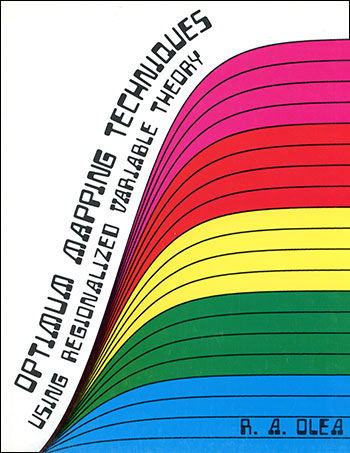
Kansas Geological Survey, Spatial Analysis Series 2, originally published in 1975

Originally published in 1975 as Kansas Geological Survey Spatial Analysis Series 2. This is, in general, the original text as published.
Much of the material presented in this report is part of a previous work (Olea, 1972), revised and enlarged during 1974-1975 while the author served as Visiting Research Scientist with the Kansas Geological Survey. This report describes the methods of universal kriging and drift as applied to mapping and map analysis by computers. Based on the theory of regionalized variables developed by G. Matheron, this work contains a detailed derivation of all steps leading from the theory to its practical use. However, a basic knowledge of geologic exploration, numerical analysis, and familiarity with statistics is assumed.
The computer algorithms to perform universal kriging and drift analysis are implemented as FORTRAN IV modules in the SURFACE II graphics system developed by the Kansas Geological Survey. Operational instructions for the programs are contained in the SURFACE II User's Manual by Robert J. Sampson (1975). Inquiries concerning these programs should be sent to the Geologic Research Section, Kansas Geological Survey, 1930 Avenue "A", Campus West, Lawrence, Kansas 66044.
I am grateful to my company, Empresa Nacional del Petroleo, Chile, for releasing the data used as examples and for giving me the opportunity to join the Kansas Geological Survey. A special thanks is due to Dr. John C. Davis, Kansas Geological Survey, for encouragement and help during preparation of the manuscript. Finally, I would like to acknowledge the valuable comments of Drs. John H. Doveton and John C. Tipper of the Kansas Geological Survey.
Ricardo A. Olea
Lawrence, Kansas
June 1975
The theory of regionalized variables has been developed by G. Matheron to allow the drawing of statistical inferences, considering not only sample values but also implicit relationships in the geometry of the sample space. Two aspects of the theory are analyzed in this report; universal kriging and drift. Universal kriging is an estimation procedure presented as an alternative for grid generation in the automatic contouring of point observations.
Drift estimations relate to the search for a slowly varying spatial component such as that usually studied by trend surface analysis. Both universal kriging and drift estimation are more general, theoretically satisfying, and reliable than the empirical methods which are now used. In addition, provided the assumptions of the regionalized variable theory are met, the resulting estimates are unbiased with minimum estimation variance. Most importantly, the methods yield the variance of the estimation error at every point in the sample space.
Basic concepts of the regionalized variable theory which pertain to automatic contouring are expressed in this report in terms of classical statistical inference. Because published accounts of the theory are highly compact, it is necessary to provide extensive derivations of the steps in its development. These lead from the fundamental assumptions of the theory to the algorithms required to perform punctual kriging and to estimate the drift, and provide an explanation of the properties of the estimates. The practical utility of these methods is shown in an example using data on a subsurface geologic horizon. Additional proofs are contained in appendices.
Kansas Geological Survey
Placed on web Jan. 17, 2019; originally published 1975.
Comments to webadmin@kgs.ku.edu
The URL for this page is http://www.kgs.ku.edu/Publications/Bulletins/SpA2/index.html